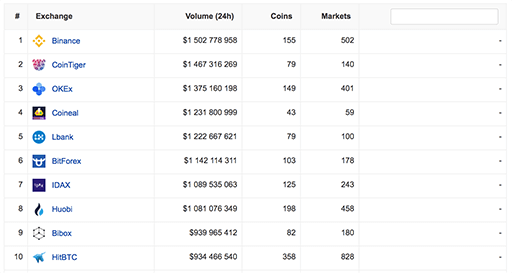Table of Contents
- Cross exchange trading: it’s just better
- Managing multiple exchanges like a pro
- Putting automated trading bots to work
With the Bitcoin price keeping its upward trend and the major altcoins in the green, a lot of cryptocurrency exchanges have seen a surge in their traffic. However, unlike (most) stocks, cryptocurrencies are far more volatile and unpredictable, especially since they run on a 24/7/365 market. Today the market is green, tomorrow it’s red. Everything is faster and less forgiving in the world of crypto compared to traditional stocks. The flip side, though, is that much larger profits are a reality thanks to these massive market swings. Are you looking to maximize on these? The best way is to double down by trading on multiple exchanges at once. If you’re still trading on just one exchange you’re living in the past; here’s why…
Cross exchange trading: it’s just better
As cryptocurrency enthusiasts, we all started out by using just one exchange to get our feet wet. And what specific exchange that was isn’t really important (so long as your first exchange wasn’t Mt. Gox, oof). And many of us, unfortunately, probably never left the safe haven of that one exchange we grew to know and love. That exchange is just too familiar, and sure we’re looking at other exchanges offering slightly different prices and maybe we wonder about arbitrage, wonder about playing the market, and wonder about different fee schedules, different coins, and different opportunities, but we usually stay put.
But branching out is hard, especially when you already have an exchange where you comfortably trade LTC against BTC during your off time. But did you ever think about all the times you weren’t trading (because you were sleeping, or you were at work, or you were trying to have a life outside of crypto) where the market jumped, or worse, tanked? There are ways to remove these downtimes through automated trading, but we’ll touch more on that later. For now let’s come to a consensus on the pros and cons of using multiple exchanges.

The dream scenario is to be able to benefit from the pros of both without suffering any of the cons, and, in a perfect world, this would be how everyone is trading. In an imperfect world (the one we reside in), there are some traders who are accessing all of these pros without suffering the cons, but most are not. Are you?
Managing multiple exchanges like a pro
When it comes to trading on multiple exchanges it can seem very daunting at first, but don’t worry, once you are a little more experienced you’ll realize it is still a daunting endeavour - just one that you can manage. There are two distinct ways that people manage trading across exchanges, manually and automated. We’re big fans of the latter, since it should be a basic human right that robots do everything for us, right?
The former, manual trading, is very simple and very similar to trading on one exchange. In fact, it is so similar to trading on one exchange that you basically just take everything you know about trading on one exchange and apply it to the other exchanges. The benefits that you’ll experience once you start trading on multiple exchanges at once will be apparent: better prices, the ability to dabble in market arbitrage, and avoiding downtime. Unfortunately, the cons from above will also come with, and you may find that half of your time is spent verifying your 2FA everytime you switch tabs to a different exchange that has automatically logged you out.

Source: coinpaprika.com
There are methods that can make your life easier when manually trading across multiple exchanges; these are known as aggregators. An exchange aggregator is a platform that partners with multiple exchanges (the more the better) to offer users a seamless and simplified cross-exchange trading experience. They do this by combining all of the information a user would need (trading pair prices, listed coins, trends, etc.) into one easily accessible place. One important difference between aggregators and exchanges is that the aggregator should never have access to your coins, wallets, etc. Manual aggregators sound just about perfect, but in our opinion they don’t push the envelope far enough - they have all this data but don’t do anything special with it, which is where [ro]bots step in.
Putting automated trading bots to work
Automation is the future, and artificial intelligence is probably going to carry us further than we’ve ever been before – but until that day we have to rely on our own intelligence in combination with automation to progress and excel. Automation in cryptocurrency trading, or crypto-bots, are far more efficient when it comes to trading than the average human. Think of all the things that we love about being human that simply don’t translate well into the data management world: we are emotional, we act on impulse, we forget things, we get tired, etc.
Crypto-bots take the emotion out of the trading equation while still leaving humans in control, giving users a chance to step back and look at the data while their bots execute the actual trades at specific times and triggers. There are a few things you want to pay attention to when choosing a company: price, ease of use, and customer support.
Price
For the beginner who is first entering into the crypto-bot world, fees play a big influence on what product they are going to choose. Most automated aggregators earn money through a monthly subscription; the ones who charge you based on each individual trade should be avoided. Prices can range anywhere from free to hundreds of dollars per month, and what you receive often scales with the pricing (to an extent). 3Commas, for example, ranges from $22-$75/month, and Cryptohopper is a bit cheaper, starting from $19, but it mostly just depends on what you’re looking for.
There is also TradeSanta crypto-bot that has a beginner plan that is free. When first entering into bot trading definitely go with the free option to learn the ropes, and since it has advanced options you can scale up in their monthly subscriptions as you see fit.
Ease of Use
Crypto-bots are useless if you don’t know how to manage them. Some companies offer extremely complex services that are certainly useful if you’re a professional trader, but if you’re just looking to spruce up your current trading then stick to what you know and branch out from there. TradeSanta keeps things simple with a well-designed UI, easy to understand language, and bots that even your grandmother could set up (if she’s into trading, why not?). Cryptohopper is another option for simplicity, as their “copy bot” option means you don’t even have to design your own strategies, but it does come with a price tag.
Customer Support
This is a big one. You don’t want your bot to malfunction or go offline and not be able to get it fixed immediately. A lot of companies like TradeSanta and 3Commas use the Telegram messaging app for support. This is more convenient since they also give users the option to route notifications on trades and bots through Telegram as well, making it a one-stop shop for managing your bots.

Source: dilbert.com
Combining ease of use with free basic plans, users who have never worked with crypto-bots before can easily jump in, connect their exchanges, and have bots set up before dinner. As you grow you may move onto a paid plan on TradeSanta, but be sure to start with something you can understand.
The future of trading is here, and if you want to keep up (and keep your day job) you’d better adopt them. Sure you could quit your job, spend all day and night sitting in front of your computer, sleep when trade volumes are low, completely neglect your health and social life, and probably carve out a career as a successful trader. But if that doesn’t sound fun then you should look into crypto-bots, because they will follow your commands while you are living your life, and even though you aren’t at your computer 24/7 your trading bots will be.
Investment Disclaimer








